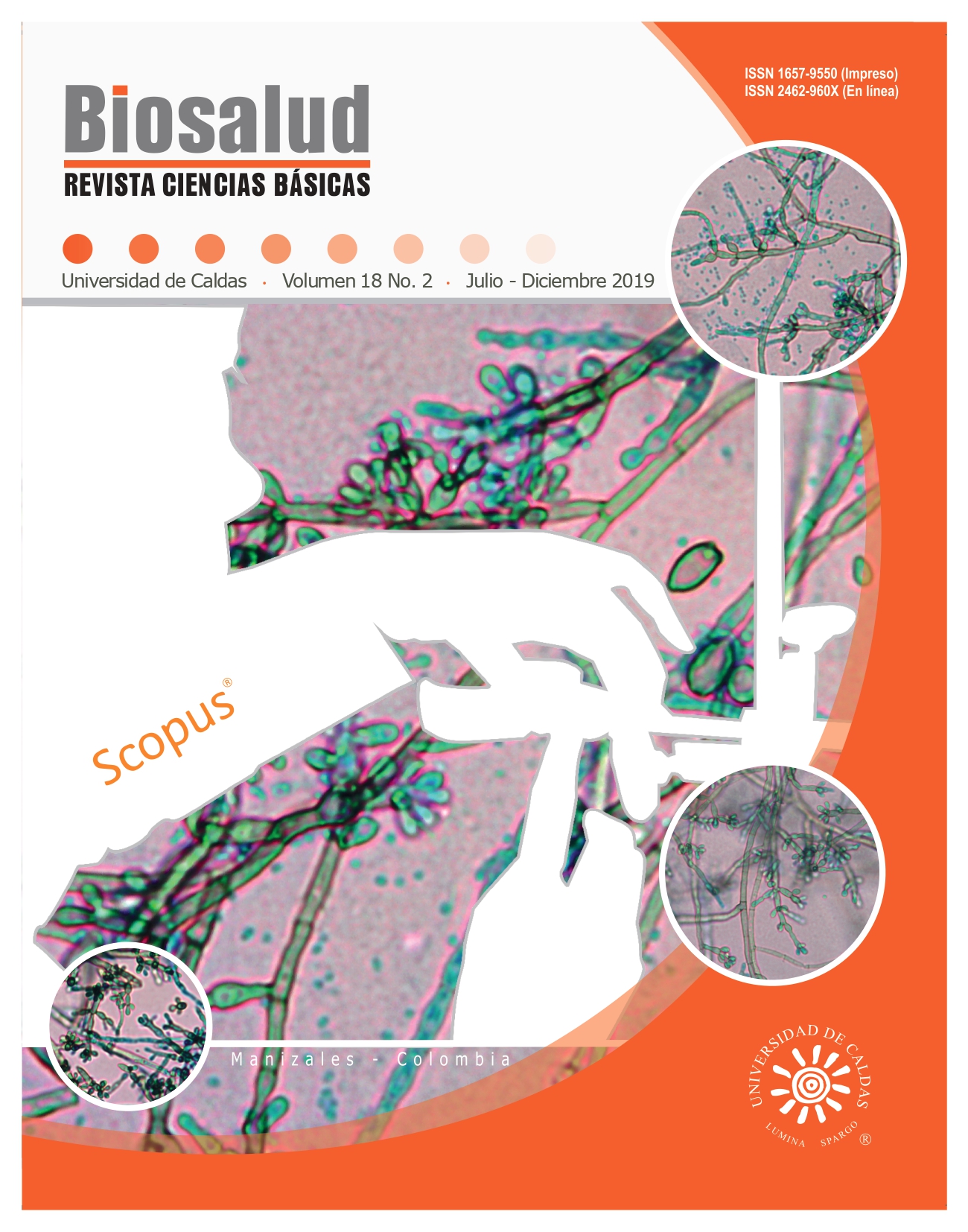Authors
Abstract
Introduction: The presence of fungemia in cancer patients represents a risk of clinical complications, the behavior of this infection is diverse in populations, which limits its management and prevention. The incidence of fungemia in Colombia is higher than that of other countries and the studies carried out in this population are scarce, for this reason it is important to determine the clinicopathological characteristics and the fungal profile of the fungemias in oncological patients of an institution in Eje Cafetero. Methodology: A descriptive, retrospective and cross-sectional study was carried out in a highly complex oncology institution that included patients hospitalized between 2017 and 2021. Results: a sample of 60 patients was obtained, oncological diagnoses were divided into two groups, solid cancer (43.3 %) and hematological cancer (56.7 %), predominantly fungemias non-albicans Candida in 56.7 %, in addition, yeasts of the Cryptococcus group were identified in 10 % of the sample. The most common comorbidity in this population was hypertension, although no association with infection was found. Patients diagnosed with hematological oncological and febrile neutropenia were associated in patients with fungemia (P=0.02). In patients with hematological oncological diagnosis there was greater isolation of non-albicans candida (76.5 % n=26), for solid oncological diagnosis there were no differences in fungal isolates. Conclusions: The presence of invasive drugs such as the central venous catheter and the use of parenteral nutrition are common in patients with anointing, a behavior expected with the studies previously reviewed; Non-albicans Candida species predominate, rare species such as C. krusei were identified. There is greater resistance in antifungals used in first choice such as fluconazole and caspofungin.
References
2. Cortés JA, Ruiz JF, Melgarejo-Moreno LN LE. Candidemia en Colombia. Biomédica [Internet]. 2020; 40(1): 195-207. https://doi.org/10.7705/biomedica.4400
3. Colombo AL, Tobn A, Restrepo A, Queiroz-Telles F, Nucci M. Epidemiology of endemic systemic fungal infections in Latin America. Med Mycol. 2011; 49(8):785-98.
4. Chinowaita F, Chaka W, Nyazika TK, Maboreke TC, Tizauone E, Mapondera P, et al. Sepsis in cancer patients residing in Zimbabwe: Spectrum of bacterial and fungal aetiologies and their antimicrobial susceptibility patterns. BMC Infect Dis. 2020; 20(1): 1-9.
5. Li D, Li T, Bai C, Zhang Q, Li Z, Li X. A predictive nomogram for mortality of cancer patients with invasive candidiasis: a 10-year study in a cancer center of North China. BMC Infect Dis. 2021; 21(1):1-10.
6. Cervera C. Candidemia y candidiasis invasora en el adulto. Formas clínicas y tratamiento. Enferm Infecc Microbiol Clin. 2012; 30(8):483-91.
7. Pappas PG, Kauffman CA, Andes D, Benjamin Jr. DK, Calandra TF, Edwards Jr. JE, et al. Clinical practice guidelines for the management of candidiasis: 2009 update by the Infectious Diseases Society of America. Clin Infect Dis. 2009; 48:503-35. In.
8. Arboleda H, Ordóñez K; Correlación entre la epidemiología de los aislamienos de Candida spp y el consumo de antifúngicos en un hospital de tercer nivel en el eje cafetero en un periodo de 78 meses. Repositorio UTP, 2019. Disponible en: https://repositorio.utp.edu.co/server/api/core/bitstreams/8a8be644-c7f4-4c26-9a99-f29c17d033cb/content
9. Pedroza Mosquera CA, et al. Comportamiento de la candidemia en una unidad de cuidados intensivos de un hospital de Colombia durante 2015 y 2016. Rev Arg Med 2021; 9(3):277-82. http://revistasam.com.ar/index.php/RAM/article/view/644/544
10. Aguado JM, Ruiz-Camps I, Munoz P, Mensa J, Almirante B, Vázquez L, et al. Recomendaciones sobre el tratamiento de la candidiasis invasiva y otras infec_ciones por levaduras de la Sociedad Espanola de Enfermedades Infecciosas y ˜ Microbiología Clínica (SEI).
11. Wankap R, Mogo C, Niang M, Diallo A, Balloy L, Baes L, et al. Fungemia in the French department of Mayotte, Indian Ocean: A 10 years survey. J Med Mycol [Internet]. 2021; 31(1):101081. Available from: https://doi.org/10.1016/j.mycmed.2020.101081
12. Moncada PA, Candelo KD, Sierra-Ruiz M, Rosso F, Martínez LF, De Paz DA, et al. Infección invasiva por Candida spp. en pacientes inmunocomprometidos: Descripción de curso clínico experiencia diagnóstica, manejo y seguimiento en centro de alta complejidad. Infectio. 2020;24(3):143.
13. Pliego-Castañeda A, Yanez-Viguri A, López-Valle T, Valdés-de la Torre F. Prevalencia y sensibilidad de Candida albicans en cultivos obtenidos en un hospital oncológico. Gac Med Mex. 2000; 136(3):193-9.
14. Villanueva F, Veliz J, Canasa Calvo K, Bellido E, Martell S, Ortega S, et al. Características de las fungemias en un centro de referencia del Perú: análisis retrospectivo de cinco años. Rev Peru Med Exp Salud Publica. 2020; 37(2):276-81.
15. Díaz-García J, Mesquida A, Sánchez-Carrillo C, Reigadas E, Muñoz P, Escribano P, et al. Monitoring the epidemiology and antifungal resistance of yeasts causing fungemia in a tertiary care hospital in Madrid, Spain: Any Relevant Changes in the Last 13 Years? Antimicrob Agents Chemother. 2021; 65(4).
16. Xiao JL, Xu GC, de Hoog S, Qiao JJ, Fang H, Li YL. Oral prevalence of candida species in patients undergoing systemic glucocorticoid therapy and the antifungal sensitivity of the isolates. Infect Drug Resist. 2020; 13:2601-7.
17. Schmalzle SA, Buchwald UK, Gilliam BL, Riedel DJ. Cryptococcus neoformans infection in malignancy. Mycoses. 2016; 59(9):542-52.
18. Pérez J, Hernández J, Rojas A, Correa R, Cañón W FM. Caracterización de la sensibilidad a los antifúngicos de especies de Candida aisladas de adultos mayores inmunocompetentes en cuidados intensivos (Caldas‚ Colombia). Infectio, 2018; 22:30.
19. Cortés J, Gómez C, Reyes P, Ariza B, Montañez A, Carreño A. Vigilancia de candidemia en Colombia entre 2008 a 2010. Infectio, 2018;Vol. 22:30.

 PDF (Español)
PDF (Español)
 FLIP
FLIP


















